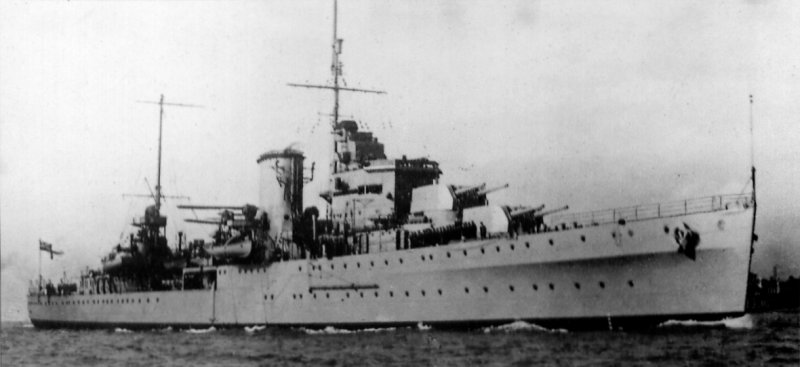HMS Ajax (22)
|
|
|
|---|---|
| Construction and service time | |
| Shipyard |
Vickers Armstrongs Ltd , Barrow-in-Furness |
| Keel laying | February 7, 1933 |
| Launch | March 1, 1934 |
| Commissioning | June 3, 1935 |
| Whereabouts | Sold for scrapping July 19, 1949 |
| Technical specifications | |
| Displacement | Standard 7,270 ts maximum 9,740 ts |
| length | over everything: 169 m |
| width | 17 m |
| Draft | 5.8 m |
| Armament (original) |
|
| Armament (1945) |
|
| Armor |
|
| Propulsion system |
|
| speed | 32.5 kn |
| Driving range | 5730 nm at 13 kn |
| crew | 550 (peace) 680 (war) men |
The HMS Ajax was a British light cruiser of the Leander class during the Second World War . She was best known for her battle with the German armored ship Admiral Graf Spee .
Before the war
The Ajax was built at the Vickers shipyard in Barrow-in-Furness . The keel was laid on February 7, 1933, and the launch took place on March 1, 1934. After construction work was completed on April 12, 1935, the Ajax was used in the North America and West Indies Squadron . In 1937 there was an operation against workers rebelling as part of the Oilfield Riots at Pointe-à-Pierre in southern Trinidad .
Second World War
South America
With the beginning of World War II, she served in South America. There she sank the German freighter Olinda . The German freighter Carl Fritzen and the German passenger ship Ussukuma sank themselves in order not to be upset.
She was the flagship of the Force G under Commodore Henry Harwood during the hunt for the Admiral Graf Spee . In the ensuing naval battle in front of the Río de la Plata on December 13, 1939, the Ajax was hit seven times, but caused more damage to the enemy.
The Ajax was in 1939 in Chile, to the victims of the earthquake in Concepción to help.
Mediterranean Sea
After repairs that lasted until July 1940, she was sent to the Mediterranean. On the night of October 11th to 12th, 1940, she attacked Italian units and sank the Torpedo boats Airone and Ariel of the Spica class and severely damaged the destroyer Artigliere , which was later sunk by HMS York .
The Ajax took part in the attack on Taranto , a nighttime operation using the radio compass . In March 1941 she took part in the Battle of Cape Matapan . On May 21, 1941, the Ajax was hit by bombs from a German Ju 87 of III./StG 2 ( Captain Heinrich Brücker). By May 29, 1941 she evacuated troops after the airborne battle over Crete . On May 28 and 29, the Ajax were again bombed . She then covered Operation Exporter and joined Force K in Malta in November 1941 , but was withdrawn again in February 1942.
D-Day and Post War
The cruiser was repaired in England from May to October 1942. He then returned to the Mediterranean, where he was again damaged by bombs. After repairs in New York between March and October 1943, the Ajax was used again in the Mediterranean.
As part of Force K, she bombarded Gold Beach during Operation Overlord and later aided in Operation Dragoon . Ajax operated in the Aegean Sea during the reoccupation of Athens and the Greek Civil War .
After the war, the Ajax was part of the task force that watched the Exodus ride .
She was decommissioned in February 1948. It was supposed to be sold to Thailand , but that deal didn't materialize. It arrived in Newport on November 18, 1949 and was scrapped in November 1949.
Commemoration
The city of Ajax in Ontario was named after the ship after the sea battle off the Río de la Plata. The streets are named after crew members. "Harwood Avenue" is the city's main north-south street.
A New Zealand Antarctic expedition named the 3770 m high Mount Ajax in the Admiralty Mountains after the ship. The Ajax Icefall on King George Island is also named after the ship.
The survivors of HMS Ajax were later awarded medals by the Chilean government for aid after the earthquake.
Web links
Individual evidence
- ↑ Michael Anthony: Historical Dictionary of Trinidad and Tobago . Scarecrow Press, London 1997, ISBN 0-8108-3173-2 , pp. 9 .
- ↑ a b M.J.Whitley: Cruiser in World War II. Motorbuch Verlag, ISBN 3-613-01842-X , p. 114.
- ↑ a b Jürgen Rohwer , Gerhard Hümmelchen : Chronik des Maritime War, May 1941 , viewed on February 16, 2009
- ^ Mount Ajax ( English ) In: Geographic Names Information System . United States Geological Survey . Retrieved March 6, 2011.


